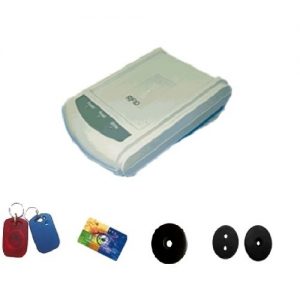With the huge variety of RFID tags available on the market, it can be confusing when attempting to select the correct one for your desired application. This page serves as a general guide on elements which should be considered when choosing a tag. The most prominent factors which affect tag selection are read range, sensor requirement, size, pricing, environmental factors, and RFID compliance standards.
Tag Types
There are 2 broad categories which most tags can be classified under. These are active and passive tags. Each holds distinct features which differentiate their applicability.
Active Tags
Active tags possess a greater read range than passive tags. The read range of active tags can extend to over 300 ft (100 meters), while passive tags typically possess a read range of about 30 ft (10 meters). However, read ranges can vary depending on product and manufacturer.
Due to the construction and battery of active tags, they are often much larger than passive tags which are usually designed as smart labels. Active tags are typically battery-powered. They last on average a couple of years, and must be replaced once the battery has been exhausted.
Active tags can be further partitioned into two distinct categories: transponders and beacons.
- Transponders – In such systems, an active RFID reader will transmit a signal first, and then the active transponder will signal information back in response. Transponder tags are highly efficient since they conserve battery life when the tag is not within the range of the reader. Transponder-type active tags see frequent usage in secure access control and toll booth payment systems.
- Beacons – In such systems, beacons output specific information in intervals between 3 – 5 seconds. An active beacon tag’s read range easily exceeds a few hundred feet (more than 100 meters), but the transmission power may be adjusted to conserve battery life. Beacon tags are widespread in the oil and gas industry, as well as having applicability in mining and cargo tracking
Most active RFID tags are encased within a protective shell which grants them increased resistance to environmental hazards such as high temperatures. In conjunction with the bulk of the enclosed battery and circuitry, the size of active RFID tags typically dwarfs passive tags. Additionally, several active tags contain sensors which measure environmental parameters. These sensors can track key measurements, such as temperatures and humidity, that a customer may wish to use for their application. Active tags are most frequently utilized in the real-time tracking of high-value assets.
Passive Tags
Passive tags are typically much less expensive than active tags. When a passive tag is not located within an interrogation zone, it has no power and does not function. They lack an internal source of power and instead derive it from the electromagnetic energy emitted from an RFID reader. A standard passive tag consists of an integrated circuit (IC) and an internal antenna, a structure also referred to as an RFID inlay. Because of the lack of internal power, passive tags do not hold the capability to contain any kind of sensors that require continuous power. Passive tags are typically designed with the minimum functionality of carrying and transmitting small quantities of data. They are typically much simpler and inexpensive compared to active tags.
Passive RFID tags operate at a wide variety of frequencies. Frequency range strongly determines the attributes of passive tags such as read range, environmental resilience, and applicability. Three common distinctions are noted below:
- 125 – 134 kHz – Low Frequency (LF): An extremely long wavelength with a read range spanning 0.5 – 4 inches (2 – 10 cm). This frequency is typically used with livestock tracking because it is not affected much by water or metal compared to higher frequency options.
- 13.56 MHz – High Frequency (HF) & Near-Field Communication (NFC): A medium wavelength with a typical read range of about 0.5 inches to 3 feet (2cm – 1 meter). These are often utilized in access control applications, and other applications which do not require long read ranges.
- 865 – 960 MHz – Ultra High Frequency (UHF): A short, high-energy wavelength of about 3 feet (1 meter) which results in increased read range. Passive UHF tags may be read from an average distance of 15 – 20 feet (4 – 6 meters), but larger UHF tags can achieve up to comparatively much larger ranges of upwards of 100 feet (30 meters). Applications of this frequency include race timing, IT asset and file tracking, and laundry management.
Tag Frequencies
The selection of tag frequency rests upon elements such as read range requisites, the material to be tagged, and data rate. Both low and high-frequency tags utilize magnetic fields to transmit energy via induction. As a result, the signal is well-defined but rather weak. In contrast, ultra-high and microwave frequency tags instead exploit the electric field for energy transmission by propagation. This method offers an excellent range, but increased ambiguity in readings.
Read Range
- Low-frequency and high-frequency tags have shorter read ranges (usually a few inches) and are ideal for applications such as payment systems, where higher range poses a security risk. Additionally, utilizing long read range unnecessarily can contribute to interference.
- In applications which require a larger read range, such as tags required in a supply chain, ultra-high-frequency tags are suitable. For extreme ranges, an active tag may be considered instead.
Environmental Factors
The location of the tag is an exceedingly large factor in choosing the correct tag. First, you must consider the surface material of the tagged item. In general, RFID tags work well on materials such as plastic, wood or cardboard.
Items with aqueous contents will require the separation between the item and any UHF or microwave tag used. In this circumstance, an LF/HF tag is more suitable. HF and LF tags are suited for tracking living bodies due to their water content. The FDA has approved LF tags for human and animal implantation.
Objects with metals present an issue as well. A standard dipole RFID tag imitates the dielectric properties of the material upon which it’s situated, which explains their animosity with materials such as metal or liquid. Tags attached directly to metallic objects are detuned and fail to function well. If UHF and microwave tags are applied with a small space to allow air between the tag and the object, they will be easily read. In contrast, LF and HF tags have an increased sensitivity to metal and may require a larger air gap. Metal-mount tags which are specifically designed to work on metal surfaces can also be considered.
In addition to the material the tagged item is composed of, one must also consider the environmental conditions that the tag may encounter during its lifetime as the item travels or is used. An embedded tag may encounter high temperatures and pressures during manufacturing, and thus must be able to withstand those conditions. The environment of the tag may also affect its read range or read rate. Some considerations are as follows:
- The substrate may absorb aqueous content or may become brittle and crack.
- The adhesive may not securely fasten the tag due to moisture or chemicals.
- The interconnection between the antenna and the IC may break due to vibration or due to repeated flexing of the tag.
- The antenna may be weakened due to corrosive effects of the chemicals in the environment.
For particularly hostile environments, encapsulated tags which boast near immunity from environmental factors such as abrasion or chemicals may be used.
Finally, tag performance is affected by the position of the tag relative to the interrogator antenna. Ideally, the tag’s orientation should allow for the tag plane and the antenna plane to be parallel to each other. This positioning allows the tags to receive maximal power. As the tag is rotated, a smaller area is available to collect incoming radio waves, thereby collecting less power. Due to the correlation between reading range and collected power, orientation ultimately affects read range (lower power results in lower ranges).
RFID Standards Compliance
Tags may be chosen for compliance with set standards. Tag regulations may differ from country to country. The standards may be open, such as ISO, or proprietary. It is favorable to follow the open and popular standards, because more companies which manufacture products use these standards than proprietary ones, providing an expansive array of products. In addition, these products may be reduced in cost due to abundance, and support for them have a greater probability to remain available for longer periods of time. With the wide acceptance of EPC Gen 2 standards (ISO 18000-6c), it is best to use Gen 2–compliant products if UHF tags are to be used, as UHF tags do not have a single global standard. LF and HF tags may be used globally without a license.
ISO 18000-6C covers the communication standards set for UHF Class 1 Gen 2 ITF RFID readers and tags. ITF RFID systems are denoted by the tag modulating its data and backscattering to the reader only after the reader sends the command.
Furthermore, it defines three additional components of reader-tag interaction: the method the information is coded, how it is modulated, and the anti-collision protocols used. ISO 18000-6C states that UHF Passive systems are ITF and use Pulse Interval Encoding, Amplitude-Shift Keying, and Q-algorithm.
- Encoding or Bit-Coding: Pulse Interval Encoding (PIE) – Reader to Tag Communications
- Miller Encoded Subcarrier or Bi-Phase Space Coding (FM0) – Tag to Reader Communications
- Modulation:Amplitude-Shift Keying (ASK)
- Anti-Collision: Q-Algorithm
As an addendum, several large organizations and government agencies have stated that their suppliers must provide goods with RFID tags. Said mandates may specify tag type, frequency, amount of memory, read range, read rate and speed, and protocol to be used. Also, they may specify the method the items be tagged. For example, ISO 11784/11785 for animal identification uses 134.2 kHz tags. If supplying goods to one of the mandating organizations, tag selection may be forced with little room for choice.



